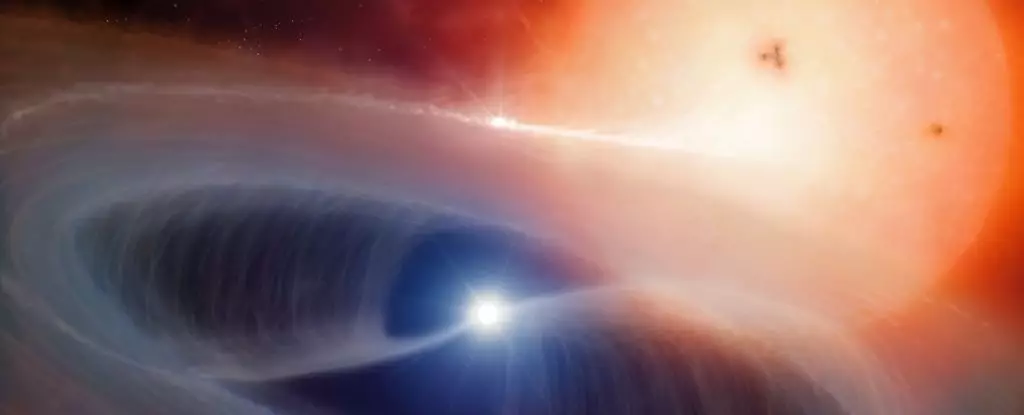The origins of metals in the universe represent one of the most compelling puzzles in astrophysics. While we understand that these elements are forged in the tumultuous environments of stellar explosions, the exact processes and progenitors involved in metal production remain elusive. Recent research led by a team of astronomers from Adam Mickiewicz University in Poland has brought new insights into the evolution of certain types of supernovae, particularly Type Ic supernovae, revealing more about the trees that produce these cosmic fires.
The Cosmic Dance: Binary Stars and Supernovae
Traditionally, Type Ic supernovae were thought to arise exclusively from massive solitary stars—specifically those exceeding 20 solar masses. These immense stars are known to undergo rapid stellar evolution, ultimately culminating in dramatic core collapse events. However, this new study introduces a paradigm shift; it suggests that the progenitors of these powerful explosions are frequently less massive stars that exist in binary systems. In such scenarios, one star siphons material from its companion, stripping it of its outer hydrogen and helium layers prior to its explosive demise. As the binary companion plays a significant role in shaping the evolution of these stars, it complicates the established narrative regarding supernova mechanics.
Michał Michałowski, one of the primary researchers, articulates this complexity: “As we delve deeper into the characteristics of massive stars, they seem increasingly intricate and interdependent.” This interdependency among stars underlines the importance of binary systems in stellar development and supernova outcomes.
Unveiling the Characteristics of Type Ic Supernovae
The mechanics of Type Ic supernovae hinge upon the core collapse of stars that have exhausted their nuclear fuel. When a massive star no longer produces sufficient energy to withstand gravitational forces, its core collapses into an ultra-dense neutron star or black hole. The outer layers then explode outward, expelling heavy elements forged during this cosmological process. Unlike other supernova classes, Type Ic events lack detectable hydrogen and helium in their ejecta, presenting a mystery that has puzzled astronomers for decades.
Two prevailing hypotheses have attempted to explain this anomaly. One proposed that the progenitor was a massive star capable of generating strong stellar winds that blew away its outer layers. The alternative suggested a smaller companion star draining the lighter elements in the envelope of a less massive star. The recent study favored the latter hypothesis, positing that binary interactions play a crucial role in the makeup of these stellar explosions.
This investigation capitalizes on observations made through the Atacama Large Millimeter Array, leveraging archival data to assess the molecular gas remnants from supernova events. By contrasting the molecular gas found around Type Ic supernovae with that of Type II supernova remnants, researchers were able to deduce the mass of the progenitor stars. They found a striking similarity in the hydrogen content across both types of supernovae, reinforcing the conclusion that the progenitors of Type Ic supernovae are indeed less massive stars than previously assumed.
Michałowski’s expectation to find only massive stars among Type Ic progenitors highlights the prevailing assumptions about stellar evolution. This research shifts our understanding, emphasizing binary systems’ foundational role in stellar life cycles and by extension, the metal production for the universe.
Following a supernova event, the binary companion generally survives the explosion, albeit at a different trajectory. Understanding the fate of these stars and their interaction reveals crucial information about the dispersal of elements throughout the cosmos. Notably, supernovae related to binary companions are known to produce more carbon—the fundamental building block of life—than their solitary counterparts. This finding necessitates a recalibration of our understanding of carbon contribution throughout the universe and highlights the broader implications of binary interactions.
Moreover, the ongoing quest to analyze more supernova remnants promises deeper insights into the lifecycle of stars, their interactions, and their subsequent contributions to cosmic inventory. As researchers seek further evidence through advanced observations, they aim to unravel additional mysteries surrounding stellar evolution, including the factors influencing the outcomes of stellar explosions.
This emerging understanding of Type Ic supernovae and their progenitors marks a significant advancement in unraveling the cosmic processes that shape our universe. The intricate relationship between stars within binary systems presents a fascinating angle in the study of stellar phenomena and the synthesis of elements. As astronomy continues to evolve with robust methodologies and technological advancements, we stand on the brink of a deeper comprehension of the universe’s creation narrative—a narrative that intricately connects the stars to the very metals that constitute much of the world around us.

